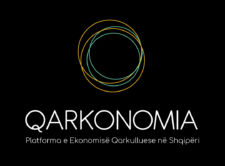© 2024 Qarkonomi. Created for free using WordPress and Kubio
Circular Economy Principles
The circular economy is based on three principles, driven by design:
1. Eliminate waste and pollution
The first principle of the circular economy is to eliminate waste and pollution. Currently, our economy works in a take-make-waste system. We take raw materials from the Earth, we make products from them, and eventually we throw them away as waste. Much of this waste ends up in landfills or incinerators and is lost. This system can not work in the long term because the resources on our planet are finite.

The problem (and the solution) starts with design
For many products on the market, there is no onward path after they are used. Take a crisp packet, for example. These multi-material
flexible plastic packages cannot be reused, recycled or composted, so end up as waste. For products like these, waste is built in. They are designed to be disposable.
Although it sometimes seems like waste is inevitable in certain situations, waste is actually the result of design choices. There is no
waste in nature, it is a concept we have introduced. From tiny, short-lived products, like crisp packets, all the way up to seemingly permanent structures like buildings and roads, the economy is filled with things that have been designed without asking: What happens to this at the end of its life?
From linear to circular
By shifting our mindset, we can treat waste as a design flaw. In a circular economy, a specification for any design is that the materials re-enter the economy at the end of their use. By doing this, we take the linear take-make-waste system and make it circular.
Many products could be circulated by being maintained, shared, reused, repaired, refurbished, remanufactured, and, as a last resort, recycled. Food and other biological materials that are safe to return to nature can regenerate the land, fuelling the production of new food and materials.
With a focus on design, we can eliminate the concept of waste.
Designers eliminating waste for a circular economy
As the concept of the circular economy has become more widely accepted as an attractive way forward, companies around the world have been rethinking the way they design, make, and remake their products.
Apeel is a company that has come up with an innovative way to eliminate single-use shrink wrap plastic packaging on fresh fruit and veg, while at the same time tackling food waste. Apeel is a layer of edible, plant-based coating applied to fresh products that mimics and enhances the natural defences of fruit and vegetables. This slows down the two main things that cause spoilage – water loss and oxidation.
Apeel is distributed to partners as a powder and mixed up with water at packaging centres. It can be applied by spray, dip, or brush on methods. Fruit and vegetables treated with Apeel stay fresh two to three times longer, without the need for plastic packaging.
Many companies are adopting reusable packaging as a way to eliminate waste, while some, like Lush and many others, are simply selling products without packaging. Lush has redesigned some of its liquid personal care products to be sold as solid formulations that replace liquid products in plastic bottles. Their ‘naked’ range now includes shampoo, conditioner, body wash, toner, and deodorant.
Eliminating waste and pollution is not limited to packaging. Textile company DyeCoo has developed a technology for dying textiles without
using water and therefore eliminates toxic waste water. Instead of water, DyeCoo uses carbon dioxide as a solvent in a closed-loop system. While the capital investment in the equipment is higher than for conventional dyeing, the company reports it can reduce operating costs due to the short batch cycles, the efficient dye use, and the avoidance of wastewater treatments. The technology can also reduce health and safety risks by minimising worker exposure to toxic chemicals.
One of DyeCoo’s machines can process 800 tons of polyester per year, effectively saving 32 million litres of water, avoiding the use of 160 tons of chemicals and completely eliminating the release of wastewater into the natural environment.
The time is now
By adopting this first principle of the circular economy, we can begin to close the materials loop and turn off the tap that is currently sending a torrent of waste into landfills and incinerators every day. With an emphasis on upstream design, we can stop waste before it is even created.

2. Circulate products and materials
The second principle of the circular economy is to circulate products and materials at their highest value. This means keeping materials in use, either as a product or, when that can no longer be used, as components or raw materials. This way, nothing becomes waste and the intrinsic value of products and materials are retained.
There are a number of ways products and materials can be kept in circulation and it is helpful to think about two fundamental cycles – the technical cycle and the biological cycle.
In the technical cycle, products are reused, repaired, remanufactured, and recycled. In the biological cycle, biodegradable materials are returned to the earth through processes like composting and anaerobic digestion.
Technical cycle
The most effective way of retaining the value of products is to maintain and reuse
them. Take a phone for example: it is far more valuable as a phone than as a pile of components and materials. So the first steps in the technical cycle are focused on keeping products whole to retain the maximum possible value. This could include business models based on sharing, so users get access to a product rather than owning it and more people get to use it over time. It could involve reuse through resale. It could mean cycles of maintenance, repair, and refurbishment.
Eventually, when the product can no longer be used, its components can be remanufactured. Parts that cannot be remanufactured can be
broken down into their constituent materials and recycled. While recycling is the option of last resort because it means the embedded value in products and components are lost, it is vitally important as the final step that allows materials to stay in the economy and not end up as waste.
Biological cycle
Biodegradable materials that cannot be reused, like some food byproducts, can be circulated back into the economy in the biological cycle. By composting or anaerobically digesting organic materials, valuable nutrients, such as nitrogen, phosphorous, potassium, and micronutrients, can be used to help regenerate the land so we can grow more food or renewable materials like cotton and wood.
Some products, like cotton clothing or wooden furniture, can be circulated through both the technical and biological cycle. They can be maintained, reused, repaired, and sometimes even recycled, but eventually they can be returned to the biological cycle from which they came. Composted or anaerobically digested, they can feed the soil to grow new cotton or wood.
Design is key to success
In order for products to successfully be circulated in either the biological or the technical cycle, it is essential they have been designed with their eventual circulation in mind. There are many products in our current economy that cannot be circulated in either cycle and end up as
waste. There are products that fuse technical and biological materials in such a way that we can’t separate them and circulate them – for example, textiles that blend natural and plastic fibres.
If designers thought about how their product could fit into the technical or biological cycles after use, that product could be made with that onward path in mind. For example, products destined for technical cycles would benefit from being easy to repair and maintain, easy to take apart, and made of modular components that can be replaced. They could be durable enough to withstand the wear and tear of many users. And they could be made from materials that are easily recycled.
If products like wooden furniture were designed – as well as to be easy to maintain and repair – with the biological cycle in mind, their biodegradable materials (like wood) would be easily separated from their technical materials (like screws) and if glues and paints were used they would be biodegradable. Other products, like takeaway food containers, can be designed to be compostable after one use so that they increase the chances of the food scraps they contain returning to the soil.
Examples of companies designing for circulation
There are many innovative companies already designing their products with recirculation in mind. Ecovative makes compostable packaging from agricultural byproducts (the parts of crops that cannot be eaten) and mycelium (mushroom roots). The packaging works like expanded polystyrene to protect fragile items in transit, but it is from a renewable source and does not contribute to plastic waste. Mycelium is a fungal network of threadlike cells that acts like a natural, self-assembling glue. It grows in 5-7 days without needing any light or water, digesting agricultural by-products and binding into any shape needed. At the end of the process, the material goes through a dehydration and heat treating process to stop the growth and to ensure the absence of spores or allergens. Once used, it can be safely composted and returned to the soil.
Resortecs has developed an innovative solution to improve the recycling of stitched clothes such as jeans and jackets that need to be taken apart before their constituent materials can be recycled. The existing disassembly process is time-consuming and costly, as the garment and its components are held together by a synthetic high-strength thread – in most cases made of polyester. Before recycling, the pieces of the garment have to be separated and the thread removed, otherwise the quality of the recycled product will be compromised. Resortecs has designed a dissolvable thread, making the disassembly process easier and helping to keep textiles in the economy.
Resortecs threads are dissolved using a commercial oven and are available for different melting-points (150oC, 170oC and 200oC) depending on the type of garment that is being taken apart. The Resortecs solution allows up to 500 kg of clothing to be dismantled at the same time.
Many companies are adopting reusable packaging as a way to keep materials in circulation. Loop, which operates in France, the UK, and the US, is a reuse platform that offers big brand products, such as Tide detergent and Heinz Ketchup, in reusable packaging. When a container is empty, there is no need for the customer to clean or sort it. It is either collected from their home or can be dropped off at participating stores. The containers are then professionally cleaned, refilled, and used again.
Time for action
By adopting the second principle of the circular economy – circulate products and materials – we retain the value embedded in products and the materials they are made from. By doing so, we keep finite materials in the economy and out of the environment, and safely return biodegradable materials to the earth.
3. Regenerate nature
The third principle of the circular economy is to regenerate nature. By moving from a take-make-waste linear economy to a circular economy, we support natural processes and leave more room for nature to thrive.

From extraction to regeneration
By shifting our economy from linear to circular, we shift the focus from extraction to regeneration. Instead of continuously degrading nature, we build natural capital. We employ farming practises that allow nature to rebuild soils and increase biodiversity, and return biological materials to
the earth. Currently, most of these materials are lost after use and the land used to grow them is depleted of nutrients.
If we move to a regenerative model, we begin to emulate natural systems. There is no waste in nature. When a leaf falls from a tree it feeds the forest. For billions of years, natural systems have regenerated themselves. Waste is a human invention.
The food industry
The obvious place to start when shifting to an economy that regenerates nature is the food industry. The way we produce food today is a significant driver of both climate change and biodiversity loss. It relies upon ever-increasing quantities of synthetic fertilisers, pesticides, fossil fuels, fresh water, and other finite resources. These are a source of pollution and damage to ecosystems and human health.
By producing our food regeneratively, the focus is on improving soil health. Regenerative farming practises can significantly reduce greenhouse gas emissions from food production by reducing reliance on synthetic inputs and by building healthy soils that absorb rather than release carbon. As well as helping restore the natural carbon cycle, healthy soils are better able to hold water, reducing the impact of droughts, and are better able to absorb water, reducing the risk of flooding.
These regenerative food production practises include agroecology, conservation agriculture, and agroforestry (growing trees around or among crops or pasture). This results in agricultural land that more closely resembles natural ecosystems like forest and native grassland, providing
habitat for a wide range of organisms, thereby increasing biodiversity. By reducing the need for synthetic inputs and pesticides, pollinators and microbes in the soils, which are essential for the maintenance of healthy ecosystems, can thrive.
More space for nature
In addition to the food system, there are other benefits for natural ecosystems by adopting a circular economy. By keeping products and materials in use, less land is required for sourcing virgin raw materials, e.g. from mines. If we gradually decouple economic activity from material extraction by keeping materials in circulation after use, more and more land can be returned to nature and rewilding can happen.
In a circular economy, land dedicated to material sourcing will increasingly be focussed on renewable resources, grown in a regenerative way, rather than the extraction of finite materials, which will increasingly remain in circulation. All this will be underpinned by a transition to 100%
renewable energy, produced using infrastructure designed for reuse, repair, remanufacture, and recycling.
Tackling climate change
Transitioning to renewable energy alone will only tackle 55% of global greenhouse gas emissions. The rest come from the way we make and use
products and food, and manage land – this is where the circular economy comes in. The economic, health, and environmental benefits of a circular economy for food alone would be worth USD 2.7 trillion a year by 2050. By adopting circular economy principles, the food industry could halve its projected greenhouse gas emissions in 2050.
Examples of companies regenerating nature
Connect the Dots is a city-led initiative to promote local regenerative agriculture in the rural zone of the state of São Paulo, protecting natural systems threatened by urban sprawl and conventional agricultural practises. The municipality purchases produce from local farmers to provide healthy food for vulnerable people. It does so at 30% more than market value to incentivise the transition to regenerative practises and promote social inclusion.
Natura is South America’s largest cosmetic company and the fifth largest beauty company in the world. It produces a huge range of products including soaps, creams, and shampoos, all of which rely on the rich biodiversity of the Amazon for ingredients and materials, as well as the
‘bio-intelligence’ of indigenous communities. The company’s supply chain includes almost 40 types of ‘biodiversity assets’ (plant-derived ingredients) and the involvement of about 7,000 families.
A key element of Natura’s business model is the concept of the ‘standing forest’ economy. In simple terms, this means that a tree has much more economic value standing than felled. This philosophy has preserved over 2 million hectares of the Amazon rainforest, with the goal of increasing this area to 3 million hectares by 2030.
The principle of regenerating nature is not limited to thelan d and can be applied to the ocean as well. GreenWave’s 3D ocean farming method produces a mixture of shellfish and seaweeds in a nature-positive way. It comprises a simple lattice of ropes and baskets suspended just below the surface, with species growing at different depths. This approach can be used for commercial farming of products used for food, fertiliser, animal feed, and bioplastics, while restoring marine ecosystems.
Regenerative ocean farms can also boost marine biodiversity. The farms’ assemblies mimic the vertical structure of an ocean reef, providing
layers of different habitats for a wide diversity of marine species.
The 3D method of regenerative ocean farming is very effective as it stacks a number of enterprises on top of each other, creating abundance in a small area. As it is fairly simple, start-up costs are low. Anyone with access to 20 acres and a boat can set up a farm for USD 20,000 –
50,000, producing about 60,000 kg of kelp and 250,000 shellfish each year.
Moving forwards
By adopting the third principle of the circular economy – regenerate nature – we can shift our priorities. No longer should our focus be simply on doing less harm to the environment, but on how we can actively improve it. If the economy follows circular principles, the more we do, the
greater the benefits.
© 2024 Qarkonomi. Created for free using WordPress and Kubio



